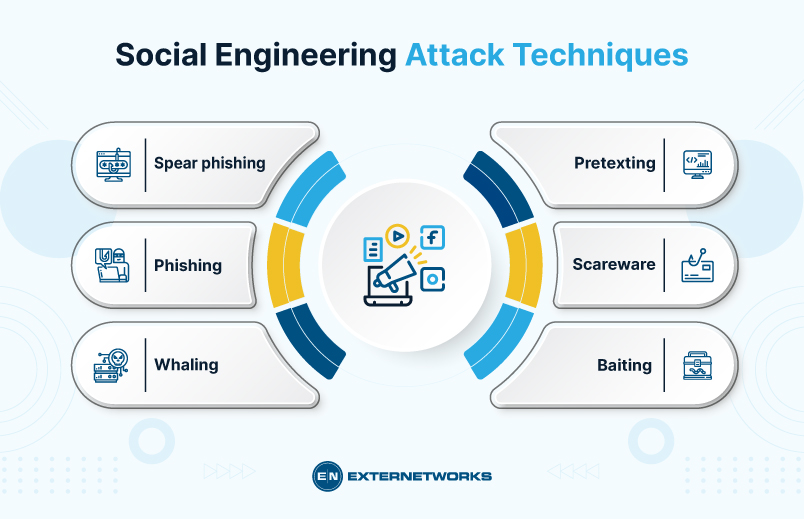Social Engineering is the art of manipulating people into doing what you want them to do. It’s a very powerful tool that anyone can use, from an individual trying to get money out of someone or steal their identity to a hacker looking for information about your network and systems. Social engineering is also known as human error hacking because it involves using human psychology to trick people into giving up information they shouldn’t have.
If an attacker gains unauthorized access to sensitive personal data (such as Social Security numbers, bank accounts, passwords for online services, etc.) by exploiting the vulnerabilities of your operating system, which may allow him/her to execute arbitrary code within your environment.
In social engineering, most common form is phishing scams. It is when hackers send emails pretending to come from legitimate companies like banks or credit card providers. The email may ask the recipient to click on a link that will download malware onto their computer. This malware could give away personal information such as usernames, passwords, bank account details, etc. Another type of social engineering tactic is spear-phishing. Spear-phishing is sending targeted messages to specific individuals within an organization. These messages are crafted so that only the intended recipients will open them. They often contain malicious links or attachments.
Social engineering attacks come in many forms and can be performed everywhere where human interaction is involved – whether online, over the phone, via email attachments, or even face-to-face.
This listed some of the most common types of social engineering attacks.

The term phishing refers to the practice of sending emails that impersonate someone else. These messages often contain malicious attachments or links to malicious websites that trick recipients into opening malware or clicking on fake web pages that collect information about them. Phishers use various tactics to ensure their messages look legitimate, including making the sender seem like a trustworthy source, such as a bank or credit card provider.
Another way of phishing attempt is voice phishing. By using phone calls they will record all your information.
In spear phishing, attackers send targeted emails to specific individuals. Spear Phishing is especially effective because people tend to trust those they know well. For example, an employee of one company might receive an email from her boss saying she won a promotion. If the recipient opens the email, he’ll likely click on a link within the message. This could lead him to a phishing website containing malware or trick him into giving up personal information.
Whaling is another type of social engineering attack that involves trying to extract sensitive data from employees. Whaling usually takes place during work hours. Attackers try to gather information about how systems operate, what applications are used, and which passwords are commonly used. They do this by asking questions about the network, looking for vulnerabilities, or searching for documents and files containing useful information.
Pretexting is another type of attack that gathers information about networks and systems. In pretexting, attackers pose as someone who has access to the system they wish to infiltrate. They pretend to need help with something, then ask for information about the network. For example, if they wanted to find out more about the security measures in place at a particular company, they would call the IT department posing as a customer.
The term scareware refers to deceptive software that tricks users into thinking their computers are infected with malware. These programs often use pop-up messages telling users their systems have been compromised and offer to fix it for a fee. However, once installed, the program does nothing to help the user. Instead, it secretly installs additional software onto the victim’s machine or redirects internet traffic to sites hosting adware or other forms of malware used.
A similar tactic used by scareware vendors is to send emails containing fake alerts about viruses and other security issues. In some cases, the messages come from well-known brands like Microsoft, Symantec, McAfee, and AVG. Others claim to be sent from tech support representatives at those companies, asking recipients to confirm whether they want to download a free virus scan. But what happens is that recipients end up downloading malware attachments.
Attacks Use False Promises To Pique Users’ Greed Or Curiosity”. The term “baiting” refers to a type of social engineering attack that lures people into clicking on something seemingly innocuous.
A common method involves placing malicious code or emails phishing disguised as legitimate documents on file-sharing sites like Dropbox or email servers. When unsuspecting users download these attachments, they unwittingly install malware attachments onto their computers.
Some baits include a physical component. For example, a hacker might place a USB stick in a public restroom stall. People picking up the device unknowingly infect themselves with malware.
A social engineer is someone who uses social skills to manipulate others into doing what he wants. He might pretend to be someone else online or attempt to befriend his target to obtain confidential information or infect him with malware attachments. A hacker can also use social engineering techniques to trick people into revealing their passwords, opening malicious files, clicking on dangerous links, downloading viruses, or installing spyware.
In conclusion, social engineering is a powerful tool that hackers can use to gain access to confidential information or devices. Cybersecurity is important for everyone, and it’s important to be aware of how social engineering can be used to compromise your security.
Security policies should be established so that organizations can help their staffs make the right decisions when it comes to phishing attacks.
Always be suspicious of emails, text messages, and other messages that seem too good to be true. If you ever feel like someone is trying to trick you, don’t hesitate to call your cyber security provider for help.
